Related Research Articles
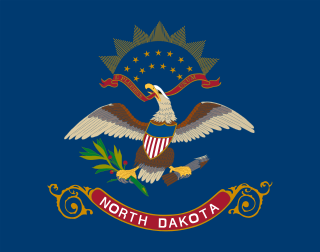
North Dakota is a landlocked U.S. state in the Upper Midwest, named after the indigenous Dakota Sioux. It is bordered by the Canadian provinces of Saskatchewan and Manitoba to the north and by the U.S. states of Minnesota to the east, South Dakota to the south, and Montana to the west. North Dakota is part of the Great Plains region, characterized by broad prairies, steppe, temperate savanna, badlands, and farmland. North Dakota is the 19th-largest state, but with a population of less than 780,000, it is the fourth-least populous and fourth-most sparsely populated. The state capital is Bismarck while the most populous city is Fargo, which accounts for nearly a fifth of the state's population; both cities are among the fastest-growing in the U.S., although half of all residents live in rural areas.

South Dakota is a landlocked state in the North Central region of the United States. It is also part of the Great Plains. South Dakota is named after the Dakota Sioux tribe, which comprises a large portion of the population — with nine reservations currently in the state — and has historically dominated the territory. South Dakota is the 17th-largest by area, but the fifth-least populous, and the fifth-least densely populated of the 50 United States. Pierre is the state capital, and Sioux Falls, with a population of about 213,900, is South Dakota's most populous city. The state is bisected by the Missouri River, dividing South Dakota into two geographically and socially distinct halves, known to residents as "East River" and "West River". South Dakota is bordered by North Dakota to the north, Minnesota to the east, Iowa to the southeast, Nebraska to the south, Wyoming to the west, and Montana to the northwest.

The Lakota are a Native American people. Also known as the Teton Sioux, they are one of the three prominent subcultures of the Sioux people, with the Eastern Dakota (Santee) and Western Dakota (Wičhíyena). Their current lands are in North and South Dakota. They speak Lakȟótiyapi—the Lakota language, the westernmost of three closely related languages that belong to the Siouan language family.

The Sioux or Oceti Sakowin are groups of Native American tribes and First Nations people from the Great Plains of North America. The Sioux have two major linguistic divisions: the Dakota and Lakota peoples. Collectively, they are the Očhéthi Šakówiŋ, or "Seven Council Fires". The term "Sioux", an exonym from a French transcription of the Ojibwe term Nadowessi, can refer to any ethnic group within the Great Sioux Nation or to any of the nation's many language dialects.
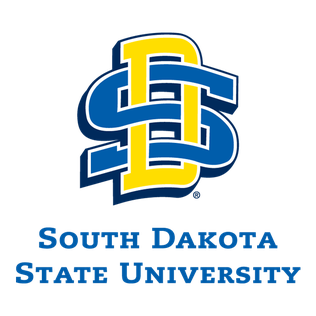
South Dakota State University is a public land-grant research university in Brookings, South Dakota, United States. Founded in 1881, it is the state's largest university and is the second oldest continually operating university in the state, trailing the University of South Dakota which was founded in 1862. The university is governed by the South Dakota Board of Regents, which governs the state's six public universities and two special schools.

Sioux Falls is the most populous city in the U.S. state of South Dakota and the 121st-most populous city in the United States. It is the county seat of Minnehaha County and also extends into northern Lincoln County to the south, which continues up to the Iowa state line. The population was 192,517 at the 2020 census, and in 2022, its estimated population was 202,078. According to city officials, the estimated population had grown to 213,891 as of early 2024. The Sioux Falls metro area accounts for more than 30% of the state's population. Chartered in 1856 on the banks of the Big Sioux River, the city is situated in the rolling hills at the junction of interstates 29 and 90.

The governor of South Dakota is the head of government of South Dakota. The governor is elected to a four-year term in even years when there is no presidential election. The current governor is Kristi Noem, a member of the Republican Party who took office on January 5, 2019.

The University of South Dakota (USD) is a public research university in Vermillion, South Dakota. Established by the Dakota Territory legislature in 1862, 27 years before the establishment of the state of South Dakota, USD is the flagship university for the state of South Dakota and the state's oldest public university. It occupies a 274 acres (1.11 km2) campus located in southeastern South Dakota, approximately 63 miles (101 km) southwest of Sioux Falls, 39 miles (63 km) northwest of Sioux City, Iowa, and north of the Missouri River.
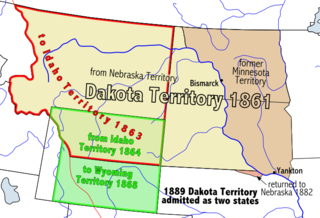
The Territory of Dakota was an organized incorporated territory of the United States that existed from March 2, 1861, until November 2, 1889, when the final extent of the reduced territory was split and admitted to the Union as the states of North and South Dakota.
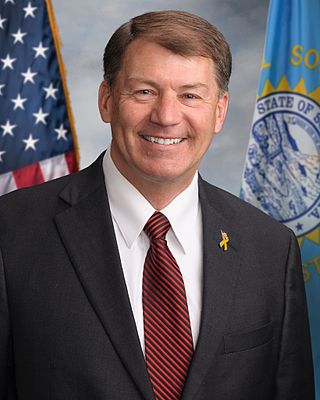
Marion Michael Rounds is an American businessman and politician serving as the junior United States senator from South Dakota since 2015. A member of the Republican Party, he served as the 31st governor of South Dakota from 2003 to 2011.

The South Dakota House of Representatives is the lower house of the South Dakota Legislature. It consists of 70 members, two from each legislative district. Two of the state's 35 legislative districts, Districts 26 and 28, are each subdivided into two single-member districts. The South Dakota House of Representatives meets at the South Dakota State Capitol in Pierre.

The Senate is the upper house of the South Dakota Legislature. It consists of 35 members, one representing each legislative district. It meets at the South Dakota State Capitol in Pierre.
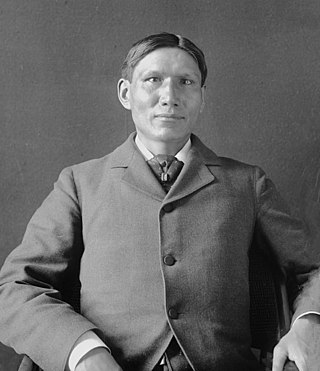
The Dakota are a Native American tribe and First Nations band government in North America. They compose two of the three main subcultures of the Sioux people, and are typically divided into the Eastern Dakota and the Western Dakota.

The South Dakota Republican Party is the affiliate of the Republican Party in South Dakota. It is currently the dominant party in the state, controlling South Dakota's at-large U.S. House seat, both U.S. Senate seats, the governorship, and has supermajorities in both houses of the state legislature. State Sen. John Wiik has served as the party's chairman since 2023.
The South Dakota State Jackrabbits football team represents South Dakota State University in college football. The program competes at the NCAA Division I Football Championship Subdivision (FCS) level as member of the Missouri Valley Football Conference (MVFC). The Jackrabbits play their home games at Dana J. Dykhouse Stadium on South Dakota State's campus in Brookings, South Dakota.

Kristi Lynn Arnold Noem is an American politician who has served since 2019 as the 33rd governor of South Dakota. A member of the Republican Party, she was the U.S. representative for South Dakota's at-large congressional district from 2011 to 2019 and a member of the South Dakota House of Representatives for the 6th district from 2007 to 2011. In November 2024, Donald Trump selected Noem to serve as Secretary of Homeland Security in his second term.

The 2022 South Dakota gubernatorial election took place on November 8, 2022, electing the governor of South Dakota. Incumbent Republican governor Kristi Noem defeated Democratic nominee Jamie Smith to win a second term.

Elections are held in the U.S. state of South Dakota regularly.